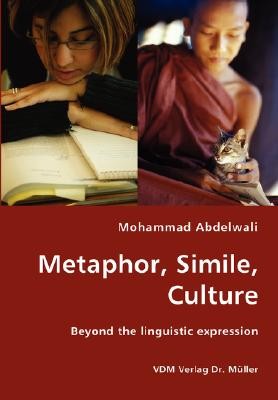
- We will send in 10–14 business days.
- Author: Mohammad Abdelwali
- Publisher: VDM Verlag Dr. Mueller E.K.
- Year: 2007
- Pages: 180
- ISBN-10: 3836425327
- ISBN-13: 9783836425322
- Format: 17 x 24.4 x 1 cm, softcover
- Language: English
- SAVE -10% with code: EXTRA
Reviews
Description
A great deal of literature recognizes that metaphors exploit similarities. However, there is little empirical research on how people from different cul-tu-ral backgrounds perceive similarity in metaphor in its simplest form X (target) is Y (source). This study thus investigates the perception of similarity in me-ta-phors from two cultural backgrounds (Arabic speakers & English speakers). A major focus is set on how the distinction between metaphors and their re-la-ted similes culturally affects the way similarity is perceived. Given that simi-la-rity is a vacuous term since any two things can be similar in one way or an-other, this study sets three major parameters; physical, behavioural, and evaluative) against which the interpretations of the two cultural groups are weighed. The analysis should help to answer the following questions: - How consistently do American and Arabian university students interpret me-ta-phors and their related similes when the metaphors and similes are presented out of context?- Does the gender of the target term make a difference in in-terpreting metaphors and their structurally related similes?-How consistently do American and Arabian university students consider their interpretation of metaphors and similes to have a cultural origin?- What cues do the par-ti-ci-pant groups use in distinguishing metaphors from non - metaphors? This book is addressed to researchers in applied linguistics and culture, as well as teachers in multicultural settings. It is also addressed to curriculum de-signers and appreciators of figurative language.
EXTRA 10 % discount with code: EXTRA
The promotion ends in 20d.17:32:19
The discount code is valid when purchasing from 10 €. Discounts do not stack.
- Author: Mohammad Abdelwali
- Publisher: VDM Verlag Dr. Mueller E.K.
- Year: 2007
- Pages: 180
- ISBN-10: 3836425327
- ISBN-13: 9783836425322
- Format: 17 x 24.4 x 1 cm, softcover
- Language: English English
A great deal of literature recognizes that metaphors exploit similarities. However, there is little empirical research on how people from different cul-tu-ral backgrounds perceive similarity in metaphor in its simplest form X (target) is Y (source). This study thus investigates the perception of similarity in me-ta-phors from two cultural backgrounds (Arabic speakers & English speakers). A major focus is set on how the distinction between metaphors and their re-la-ted similes culturally affects the way similarity is perceived. Given that simi-la-rity is a vacuous term since any two things can be similar in one way or an-other, this study sets three major parameters; physical, behavioural, and evaluative) against which the interpretations of the two cultural groups are weighed. The analysis should help to answer the following questions: - How consistently do American and Arabian university students interpret me-ta-phors and their related similes when the metaphors and similes are presented out of context?- Does the gender of the target term make a difference in in-terpreting metaphors and their structurally related similes?-How consistently do American and Arabian university students consider their interpretation of metaphors and similes to have a cultural origin?- What cues do the par-ti-ci-pant groups use in distinguishing metaphors from non - metaphors? This book is addressed to researchers in applied linguistics and culture, as well as teachers in multicultural settings. It is also addressed to curriculum de-signers and appreciators of figurative language.


Reviews